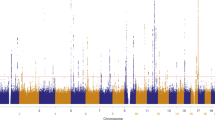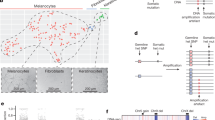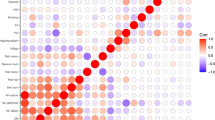Abstract
Susceptibility to most common cancers is likely to involve interaction between multiple low risk genetic variants. Although there has been great progress in identifying such variants, their effect on phenotype and the mechanisms by which they contribute to disease remain largely unknown. We have developed a mouse melanoma model harboring two mutant oncogenes implicated in human melanoma, CDK4R24C and NRASQ61K. In these mice, tumors arise from benign precursor lesions that are a recognized strong risk factor for this neoplasm in humans. To define molecular events involved in the pathway to melanoma, we have for the first time applied the Collaborative Cross (CC) to cancer research. The CC is a powerful resource designed to expedite discovery of genes for complex traits. We characterized melanoma genesis in more than 50 CC strains and observed tremendous variation in all traits, including nevus and melanoma age of onset and multiplicity, anatomical site predilection, time for conversion of nevi to melanoma and metastases. Intriguingly, neonatal ultraviolet radiation exposure exacerbated nevus and melanoma formation in most, but not all CC strain backgrounds, suggesting that genetic variation within the CC will help explain individual sensitivity to sun exposure, the major environmental skin carcinogen. As genetic variation brings about dramatic phenotypic diversity in a single mouse model, melanoma-related endophenotype comparisons provide us with information about mechanisms of carcinogenesis, such as whether melanoma incidence is dependent upon the density of pre-existing nevus cells. Mouse models have been used to examine the functional role of gene mutations in tumorigenesis. This work represents their next phase of development to study how biological variation greatly influences lesion onset and aggressiveness even in the setting of known somatic driver mutations.
This is a preview of subscription content, access via your institution
Access options
Subscribe to this journal
Receive 50 print issues and online access
$259.00 per year
only $5.18 per issue
Buy this article
- Purchase on Springer Link
- Instant access to full article PDF
Prices may be subject to local taxes which are calculated during checkout




Similar content being viewed by others
References
Gandini S, Sera F, Cattaruzza MS, Pasquini P, Abeni D, Boyle P et al. Meta-analysis of risk factors for cutaneous melanoma: I. Common and atypical naevi. Eur J Cancer 2005; 41: 28–44.
Gandini S, Sera F, Cattaruzza MS, Pasquini P, Picconi O, Boyle P et al. Meta-analysis of risk factors for cutaneous melanoma: II. Sun exposure. Eur J Cancer 2005; 41: 45–60.
Law MH, Macgregor S, Hayward NK . Melanoma genetics: recent findings take us beyond well-traveled pathways. J Invest Dermatol 2012; 132: 1763–1774.
Nadeau J . Modifier genes in mice and humans. Nat Rev Genet 2001; 2: 165–174.
Churchill GA, Airey DC, Allayee H, Angel JM, Attie AD, Beatty J et al. The Collaborative Cross, a community resource for the genetic analysis of complex traits. Nat Genet 2004; 36: 1133–1137.
Morahan G, Balmer L, Monley D . Establishment of ‘The Collaborative Cross’: a resource for rapid identification of complex trait genes. Mamm Genome 2008; 19: 390–393.
Welsh CE, Miller DR, Manly KF, Wang J, McMillan L, Morahan G et al. Status and access to the Collaborative Cross population. Mamm Genome 2010; 23: 706–712.
Threadgill DW, Churchill GA . Ten years of the collaborative cross. G3 (Bethesda) 2012; 2: 153–156.
Lifsted T, Le Voyer T, Williams M, Muller W, Klein-Szanto A, Buetow KH et al. Identification of inbred mouse strains harboring genetic modifiers of mammary tumor age of onset and metastatic progression. Int J Cancer 1998; 77: 640–644.
Crawford NP, Walker RC, Lukes L, Officewala JS, Williams RW, Hunter KW et al. The Diasporin Pathway: a tumor progression-related transcriptional network that predicts breast cancer survival. Clin Exp Metastasis 2008; 25: 357–369.
Faraji F, Pang Y, Walker RC, Nieves Borges R, Yang L, Hunter KW et al. Cadm1 is a metastasis susceptibility gene that suppresses metastasis by modifying tumor interaction with the cell-mediated immunity. PLoS Genet 2012; 8: e1002926.
Winter SF, Lukes L, Walker RC, Welch DR, Hunter KW . Allelic variation and differential expression of the mSIN3A histone deacetylase complex gene Arid4b promote mammary tumor growth and metastasis. PLoS Genet 2012; 8: e1002735.
Abel EL, Angel JM, Riggs PK, Langfield L, Lo HH, Person MD et al. Evidence that Gsta4 modifies susceptibility to skin tumor development in mice and humans. J Natl Cancer Inst 2010; 102: 1663–1675.
Ferguson B, Konrad Muller H, Handoko HY, Khosrotehrani K, Beermann F, Hacker E et al. Differential roles of the pRb and Arf/p53 pathways in murine naevus and melanoma genesis. Pigment Cell Melanoma Res 2010; 23: 771–780.
Wurm ET, Ferguson B, Li L, Lambie D, Walker GJ, Soyer HP et al. Histopathologic and clinical variability in melanocytic lesions developing in genetically modified Cdk4R24C/R24C::Tyr-Nras mice. Exp Dermatol 2012; 21: 676–681.
Lynch HT, Fusaro RM, Pester J, Lynch JF . Familial atypical multiple mole melanoma (FAMMM) syndrome: genetic heterogeneity and malignant melanoma. Br J Cancer 1980; 42: 58–70.
Lee JH, Choi JW, Kim Y . Frequencies of BRAF and NRAS mutations are different in histological types and sites of origin of cutaneous melanoma: a meta-analysis. Br J Dermatol 2011; 164: 776–784.
Puig S, Ruiz A, Castel T, Volpini V, Malvehy J, Cardellach F et al. Inherited susceptibility to several cancers but absence of linkage between dysplastic nevus syndrome and CDKN2A in a melanoma family with a mutation in the CDKN2A (P16INK4A) gene. Hum Genet 1997; 101: 359–364.
de Snoo FA, Hottenga JJ, Gillanders EM, Sandkuijl LA, Jones MP, Bergman W et al. Genome-wide linkage scan for atypical nevi in p16-Leiden melanoma families. Eur J Hum Genet 2008; 16: 1135–1141.
Goldstein AM, Chidambaram A, Halpern A, Holly EA, Guerry D, Sagebiel R et al. Rarity of CDK4 germline mutations in familial melanoma. Melanoma Res 2002; 12: 51–55.
Molven A, Grimstvedt MB, Steine SJ, Harland M, Avril MF, Hayward NK et al. A large Norwegian family with inherited malignant melanoma, multiple atypical nevi, and CDK4 mutation. Genes Chrom Cancer 2005; 44: 10–18.
Falchi M, Bataille V, Hayward NK, Duffy DL, Bishop JA, Pastinen T et al. Genome-wide association study identifies variants at 9p21 and 22q13 associated with development of cutaneous nevi. Nat Genet 2009; 41: 915–919.
Le Fur N, Kelsall SR, Mintz B . Base substitution at different alternative splice donor sites of the tyrosinase gene in murine albinism. Genomics 1996; 37: 245–248.
Walker GJ . Cutaneous melanoma: how does ultraviolet light contribute to melanocyte transformation? Future Oncol 2008; 4: 841–856.
Pollock PM, Cohen-Solal K, Sood R, Namkoong J, Martino JJ, Koganti A et al. Melanoma mouse model implicates metabotropic glutamate signaling in melanocytic neoplasia. Nat Genet 2003; 34: 108–112.
Quigley D, Balmain A . Systems genetics analysis of cancer susceptibility: from mouse models to humans. Nat Rev Genet 2009; 10: 651–657.
Viros A, Fridlyand J, Bauer J, Lasithiotakis K, Garbe C, Pinkel D et al. Improving melanoma classification by integrating genetic and morphologic features. PLoS Med 2008; 5: e120.
Walker GJ, Soyer HP, Terzian T, Box NF . Modelling melanoma in mice. Pigment Cell Melanoma Res 2011; 24: 158–176.
Hodis E, Watson IR, Kryukov GV, Arold ST, Imielinski M, Theurillat JP et al. A landscape of driver mutations in melanoma. Cell 2012; 150: 251–263.
Campagne C, Reyes-Gomez E, Battistella M, Bernex F, Château-Joubert S, Huet H et al. Histopathological atlas and proposed classification for melanocytic lesions in Tyr::NRas(Q61K);Cdkn2a(−/−) transgenic mice. Pigment Cell Melanoma Res 2013; 26: 735–742.
Landsberg J, Gaffal E, Cron M, Kohlmeyer J, Renn M, Tüting T et al. Autochthonous primary and metastatic melanomas in Hgf-Cdk4 R24C mice evade T-cell-mediated immune surveillance. Pigment Cell Melanoma Res 2010; 23: 649–660.
Chai E, Ferguson B, Prow T, Soyer HP, Walker GJ . Three-dimensional modelling for estimation of nevus count and probability of nevus-melanoma progression in a murine model. Pigment Cell Melanoma Res 2013; 27: 317–319.
Rigel DS . Cutaneous ultraviolet exposure and its relationship to the development of skin cancer. J Am Acad Dermatol 2008; 58: S129–S132.
Whiteman DC, Watt P, Purdie DM, Hughes MC, Hayward NK, Green AC et al. Melanocytic nevi, solar keratoses, and divergent pathways to cutaneous melanoma. J Natl Cancer Inst 2003; 95: 806–812.
Aoki H, Hara A, Motohashi T, Kunisada K . Functionally distinct melanocyte populations revealed by reconstitution of hair follicles in mice. Pigment Cell Melanoma Res 2011; 24: 125–135.
Bradish JR, Montironi R, Lopez-Beltran A, Post KM, MacLennan GT, Cheng L et al. Towards personalized therapy for patients with malignant melanoma: molecular insights into the biology of BRAF mutations. Future Oncol 2013; 9: 245–253.
Rane SG, Dubus P, Mettus RV, Galbreath EJ, Boden G, Reddy EP et al. Loss of Cdk4 expression causes insulin-deficient diabetes and Cdk4 activation results in beta-islet cell hyperplasia. Nat Genet 1999; 22: 44–52.
Ackermann J, Frutschi M, Kaloulis K, Mckee T, Trumpp A, Beermann F et al. Metastasizing melanoma formation caused by expression of activated N-RasQ61K on an INK4a-deficient background. Cancer Res 2005; 65: 4005–4011.
Acknowledgements
This work was supported by a pilot study grant from the Melanoma Research Alliance, Washington DC, USA and a Discovery Research Priming Grant from the Scott Kirkbride Melanoma Research Centre, Perth, Western Australia. GM is supported by the Diabetes Research Foundation of Western Australia, by Australian Research Council Project DP11010206 and by Program Grant 1037321 from the National Health and Medical Research Council of Australia. RR is supported by RTCC funding from the Ride To Cure Cancer, Western Australia. We thank Geniad Pty Ltd for providing mice from the Collaborative Cross strains.
Author information
Authors and Affiliations
Corresponding author
Ethics declarations
Competing interests
The authors declare no conflict of interest.
Additional information
Supplementary Information accompanies this paper on the Oncogene website
Rights and permissions
About this article
Cite this article
Ferguson, B., Ram, R., Handoko, H. et al. Melanoma susceptibility as a complex trait: genetic variation controls all stages of tumor progression. Oncogene 34, 2879–2886 (2015). https://doi.org/10.1038/onc.2014.227
Received:
Revised:
Accepted:
Published:
Issue Date:
DOI: https://doi.org/10.1038/onc.2014.227
This article is cited by
-
Genetic mapping of novel modifiers for ApcMin induced intestinal polyps’ development using the genetic architecture power of the collaborative cross mice
BMC Genomics (2021)
-
E2f8 and Dlg2 genes have independent effects on impaired insulin secretion associated with hyperglycaemia
Diabetologia (2020)
-
Variable outcomes of human heart attack recapitulated in genetically diverse mice
npj Regenerative Medicine (2019)
-
Profiling and genetic control of the murine immunoglobulin G glycome
Nature Chemical Biology (2018)
-
Genome wide in vivo mouse screen data from studies to assess host regulation of metastatic colonisation
Scientific Data (2017)



